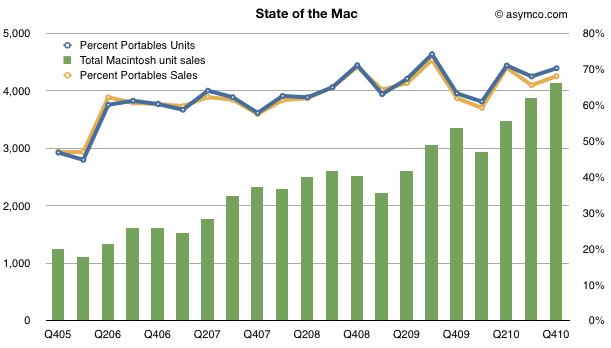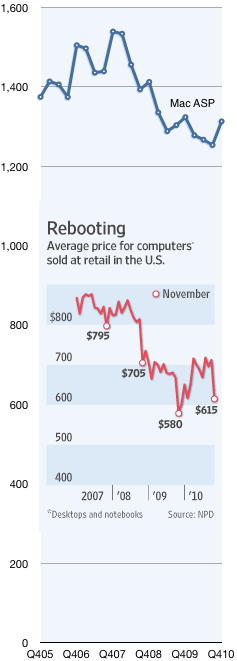Apple set a new record for Mac sales in the fourth quarter. This was not a surprise. The growth was perhaps a bit lower than some expected (including me) but it was still a healthy 23% and 8x the PC growth rate. The Mac has outgrown the PC (and hence has gained share) for 19 quarters straight, nearly five years.
What’s more interesting is where the growth came from. Every region outgrew the market. Asia-Pacific led with a 67% year-over-year increase, almost 10x the market. Japan grew at 56%, which is about 6x the market, and Europe and the United States both grew in double-digits despite both markets contracting overall.
Looking over a longer time frame, the Mac has nearly quadrupled in volume in five years. In the last quarter of 2005, Apple sold 1.2 million units. In the latest quarter it sold 4.1 million. So the performance has been relatively good.
One significant reason for the growth has been the shift from desktop to portables. The lines show how the percent of portables went from about 50% to 70% of units and sales in four years.
[hang1column]
[/hang1column]
But what was surprising was that the average selling price increased to $1,313, up from $1,253 and nearly even with last year’s $1,324.
Prices in the PC industry tend to fall. Actually, to be more precise, they tend to collapse. Compare the Mac’s price trend with the rest of the industry as seen in the chart to the left[1]. It shows the Mac Average Selling Price which is what Apple books from selling into the channel vs. the retail price of PCs in the US.
The chart tells a partial story. The PC figures are retail while the Mac figures are wholesale. Furthermore, the PC figures include Mac, so stripping out the Mac would show the PC prices to be even lower. Lastly the Mac figures are global whereas the PC figures are US only.
But what I want to focus on is not the absolute difference, rather the relative value difference, which is diverging: The average PC went from $795 retail at the end of 2007 to $615 in November 2010. That’s a drop of 22%. In the same time frame the Mac went from $1,539 to $1,313 wholesale, a drop of 15%.
In other words, the Mac price premium at the end of 2007 was at least 93% and it now is at least 114%.
So here’s the real surprise: How does the Mac gain share while increasing its price premium over the PC?
The only answer I can offer is what I already wrote on the Mac in November:
…something changed with PCs when the laptop became “good enough”. With portable computing, the job the PC was hired to do evolved. It was more important that the product be well designed (for aesthetic value, usability and reliability) than just fast and spacious. The microprocessors were plenty fast but what mattered more was low power consumption, a low profile and tighter integration with software.
In other words, computers became re-integrated. You only need to touch the MacBook Air to understand why.
—-
Notes:
- The inset chart comes from The Wall Street Journal using data from NPD. The Mac data comes from Apple financial reports.
Discover more from Asymco
Subscribe to get the latest posts sent to your email.


